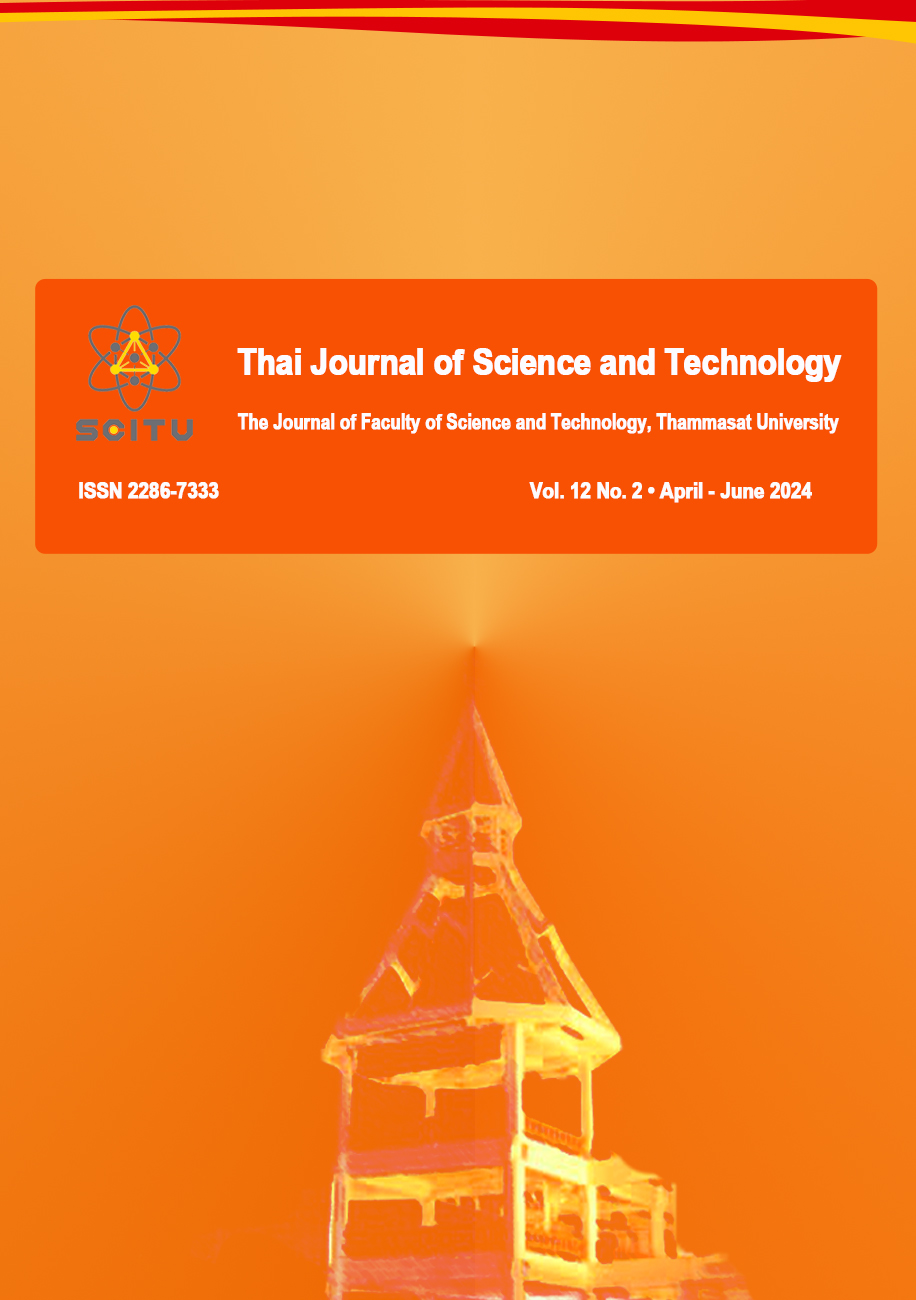การวิเคราะห์ความคุ้มค่าทางเศรษฐศาสตร์และการลดก๊าซเรือนกระจกของการติดตั้งระบบผลิตพลังงานแสงอาทิตย์บนหลังคาอาคารหอพัก ภายในมหาวิทยาลัยธรรมศาสตร์ ศูนย์รังสิต
Main Article Content
บทคัดย่อ
พลังงานแสงอาทิตย์เป็นพลังงานที่เป็นมิตรต่อสิ่งแวดล้อมที่ช่วยสนับสนุนการเข้าสู่ความเป็นกลางทางคาร์บอนของประเทศไทย งานวิจัยนี้เป็นการวิเคราะห์ความคุ้มค่าการติดตั้งระบบผลิตไฟฟ้าพลังงานแสงอาทิตย์บนหลังคาบนอาคารหอพักภายในมหาวิทยาลัยธรรมศาสตร์ศูนย์รังสิตเพื่อลดการใช้ไฟฟ้าจากระบบโครงข่ายไฟฟ้า ผลการศึกษาพบว่ากำลังการผลิตติดตั้งที่เหมาะสมกับพฤติกรรมการใช้ไฟฟ้าของผู้พักอาศัยมีค่าประมาณ 1.4 MWp สามารถผลิตไฟฟ้าได้ประมาณ 1,881,337 kWh/ปี คิดเป็นปริมาณการลดการปล่อยก๊าซเรือนกระจกได้เท่ากับ 914 tCO2e/ปี เมื่อพิจารณาผลตอบแทนทางเศรษฐศาสตร์พบว่าโครงการมีความคุ้มค่าทางเศรษฐศาสตร์โดยในแง่ต้นทุนโครงการมีต้นทุนการผลิตไฟฟ้าต่อหน่วยปรับเฉลี่ย (LCOE) อยู่ระหว่าง 2.34-2.68 บาท/kWh และในแง่ผลตอบแทน โครงการมีอัตราผลตอบแทนภายใน (IRR) ระหว่าง 15.35 – 18.45% และมีระยะเวลาคืนทุนประมาณ 5-6 ปี ผลการวิเคราะห์ความอ่อนไหว (sensitivity analysis) โดยพิจารณาปัจจัย (1) สัดส่วนการใช้ไฟฟ้าที่ผลิตได้เอง (2) อัตราการเสื่อมของเซลล์แสงอาทิตย์ และ (3) ค่าใช้จ่ายในการบำรุงรักษา สรุปได้ว่า สัดส่วนการใช้ไฟฟ้าที่ผลิตได้เองเป็นปัจจัยสำคัญที่ส่งผลต่อความคุ้มค่าของโครงการ โดยโครงการจะมีความคุ้มค่าเมื่อสัดส่วนการใช้ไฟฟ้าที่ผลิตได้เองสูงกว่าประมาณ 60% ขึ้นไป ส่วนอีก 2 ปัจจัยไม่ส่งผลต่อความคุ้มค่าของโครงการอย่างมีนัยสำคัญ
Article Details

อนุญาตภายใต้เงื่อนไข Creative Commons Attribution-NonCommercial-NoDerivatives 4.0 International License.
บทความที่ได้รับการตีพิมพ์เป็นลิขสิทธิ์ของคณะวิทยาศาสตร์และเทคโนโลยี มหาวิทยาลัยธรรมศาสตร์ ข้อความที่ปรากฏในแต่ละเรื่องของวารสารเล่มนี้เป็นเพียงความเห็นส่วนตัวของผู้เขียน ไม่มีความเกี่ยวข้องกับคณะวิทยาศาสตร์และเทคโนโลยี หรือคณาจารย์ท่านอื่นในมหาวิทยาลัยธรรมศาสตร์ ผู้เขียนต้องยืนยันว่าความรับผิดชอบต่อทุกข้อความที่นำเสนอไว้ในบทความของตน หากมีข้อผิดพลาดหรือความไม่ถูกต้องใด ๆ
เอกสารอ้างอิง
Abdallah, R., Juaidi, A., Salameh, T., Jeguirim, M., Çamur, H., Kassem, Y., & Abdala, S. (2022). Chapter 1 - Estimation of solar irradiation and optimum tilt angles for south-facing surfaces in the United Arab Emirates: a case study using PVGIS and PVWatts’, in M., Jeguirim (ed.) Recent Advances in Renewable Energy Technologies. Location: Academic Press, 3-39.
Andy, W., Lockhart, E., Desai, J., Ardani, K., Klise, G., Lavrova, O., Tansy, T., Deot, J., Fox, B., & Pochiraju, A. (2020). Model of Operation-and-Maintenance Costs for Photovoltaic Systems. Golden, CO: National Renewable Energy Laboratory. NREL/TP-5C00-74840. Retrieved from https://www.nrel.gov/docs/fy20osti/ 74840.pdf.
Bank of Thailand. (2024a). Macroeconomic Indicators. Retrieved from app.bot.or.th/BTWS_STAT/ statistics/ BOTWEBSTAT.aspx?reportID=409&language=TH. January 30, 2024. (in Thai)
Bank of Thailand. (2024b). Loan Interest Rate. Retrieved from https://www.bot.or.th/th/statistics/ interest-rate.html. January 30, 2024.
Department of Alternative Energy Development and Efficiency, Ministry of Energy. (2017). Project to Improve the Solar Potential Map from Satellite Images for Thailand. Retrieved from https://oldwww.dede.go.th/ewt_news.php?nid=47736&filename=index. January 20, 2024. (in Thai)
Energy Policy and Planning Office, Ministry of Energy. (2023). Thailand Energy Statistics Report 2023, pp 177-178. Retrieved from https://www.eppo.go.th/index.php/th/component/k2/item/19566-energy-statistics-2566. January 20, 2024. (in Thai)
Global Compact Network Thailand. (2021). Thailand's Long-term Greenhouse Gas Emission Development Strategy, presented at COP26, Thailand Pavilion Retrieved from globalcompact-th.com/news/detail/602. January 20, 2024. (in Thai)
Hadj Arab, A., Taghezouit, B., Abdeladim, K., Semaoui, S., Razagui, A., Gherbi, A., Boulahchiche, S., & Hadj Mahammed, I. (2020). Maximum power output performance modeling of solar photovoltaic modules. Energy Reports, 6(1), 680-686.
International Renewable Energy Agency. (2023). Renewable Power Generation Costs in 2022 (p. 207). Retrieved from www.irena.org/Publications/2023/Aug/Renewable-Power-Generation-Costs-in-2022
Jordan, D.C., Smith, R.M., Osterwald, C.R., Gelak, E. & Kurtz, S.R. (2011). Outdoor PV Degradation Comparison, NREL/CP-5200-47704. 7pp.
Jordan, D.C., & Kurtz, S.R. (2012). Photovoltaic Degradation Rates: An Analytical Review (NREL/JA-5200-51664). 30pp.
Koner, P.K., Dutta, V., & Chopra, K.L. (2000). A comparative life cycle energy cost analysis of photovoltaic and fuel generator for load shedding application. Solar Energy Materials and Solar Cells, 60(4), 309-322.
Limmanee, A., Udomdachanut, N., Songtrai, S., Kaewniyompanit, A., Sato, Y., Nakaishi, M., Kittisontirak, S., Sriprapha, K., & Sakamoto, Y. (2016). Field performance and degradation rates of different types of photovoltaic modules: A case study in Thailand. Renewable Energy, 89, 12-17.
Office of the National Economic and Social Development Council. (2023). Thirteenth National Economic and Social Development Plan (2023-2027). Retrieved from https://www.nesdc.go.th/main.php?filename=plan13. January 20, 2024. (in Thai)
Solarpraxis, A.G. (2011). Inverter and PV System Technology Industry Guide 2011 (RENI-Renewable Insight Energy Industry Guides, p. 98).
Thailand Greenhouse gas Management Organization (TGO). (2023a). Electricity Generation from Renewable Energy (T-VER-S-METH-01-01). Retrieved from https://ghgreduction.tgo.or.th/th/tver-method/t-ver-classify-methodology/t-ver-methodology1/item/3554-electricity-generation-from-renewable-energy.html (in Thai)
Thailand Greenhouse gas Management Organization (TGO). 2023b. Greenhouse Gas Emission Values from Electricity Generation and Consumption for Greenhouse Gas Reduction Projects and Activities. Retrievd from https://ghgreduction.tgo.or.th/th/download-tver/120-tver-gwp-emission-factor/3377-emission-factor-30-2565.html (in Thai)
United Nations Framework Convention on Climate Change (UNFCCC). (2014). AMS-I.D.: Grid Connected Renewable Electricity Generation. Retrieved from https://cdm.unfccc.int/methodologies/DB/W3TINZ7KKWCK7L8WTXFQQOFQQH4SBK
United Nations Framework Convention on Climate Change (UNFCCC). (2016). ACM0002 Grid-Connected Electricity Generation from Renewable Sources Version 17.0, Available Source: http:// cdm.unfccc.int/methodologies/DB/8W400U6E7LFHHYH2C4JR1RJWWO4PVN.


